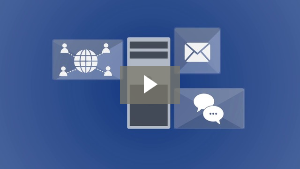From natural disasters to cyberattacks, businesses in Atlanta have seen their fair share of disasters. In fact, earlier this year, Delta Airlines suffered another huge computer outage that grounded at least 300 flights.
Although a disaster recovery plan is indeed essential for surviving these catastrophes, you must be able to communicate throughout the recovery process to increase your chances of success. This can be accomplished with unified communication (UC) systems in several ways.
Call routing
Call routing allows you to forward incoming calls to another landline or mobile device. So, if one office system goes offline due to a power outage, you can set up your UC system to redirect calls to company branches and employees unaffected by the local disaster.
Auto-attendant
During a crisis, auto-attendant features can serve as your disaster response unit. By setting automated messages, you can inform customers about the incident and how long they have to wait for service to resume. Additionally, you can set messages recommending different ways to contact the company in case of an emergency.
As soon as disaster occurs, this feature should be enabled immediately. It’s the fastest way to communicate with and appease disgruntled customers. It also manages the influx of calls, giving your in-house employees enough time to focus on getting systems back online and/or deploying a quick stopgap solution.
Contact directory
In your UC system, you can create a detailed contact directory of vendors, managers, and system administrators. Clicking on a contact displays that person’s job title, ‘presence’ (which indicates whether he or she is available), and company-registered phone numbers and emails. This digital contact list may not seem like much now, but it will be key in helping employees know which people to contact and how to get a hold of them come judgment day.
Instant messaging
While giving verbal instructions during a disaster is quick and easy, there’s a good chance your employees will forget specific details. By using the instant messaging or chat feature in your UC system, you can better relay information and provide step-by-step instructions that can be used for future reference. These chat rooms are also the perfect place for employees to continue working and collaborating while headquarters undergoes repairs.
Video calling and screen sharing
Of course, where words fail, videos can show. Video communication is an extremely powerful tool for visualizing and assessing the damage of a disaster site. For instance, if your warehouse got flooded, onsite staff could show you the damaged products and what caused the storage facility to take on water in real time. From here, you could then add the right individuals or groups into the video conference to advise your staff on how to resolve the issue.
This tool is also helpful for responding to cyberattacks. Suppose your office suffered a ransomware attack, encrypting all your local files. In this scenario, you could contact your managed IT services provider, share your screen, and have them walk you through the entire data recovery process remotely.
DR needs UC
A disaster recovery plan is a good way to ensure your business's survival. But complications can occur, and when they do, you need to be able to communicate with employees, managers, vendors, and managed IT services providers to overcome these challenges.
If you’re looking for UC systems to support your disaster recovery solutions, visit www.intelligis.com. Our IT experts in Atlanta will install a communication system that not only boosts collaboration and productivity, but also helps your business withstand any disaster, natural or manmade.


